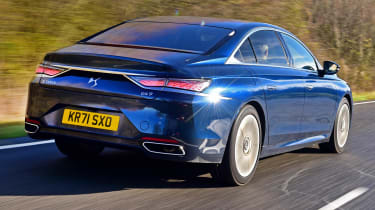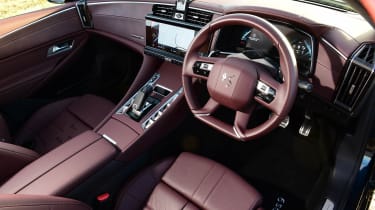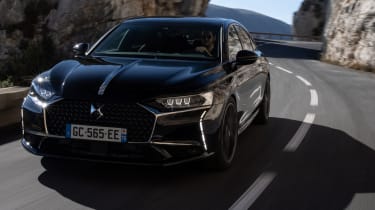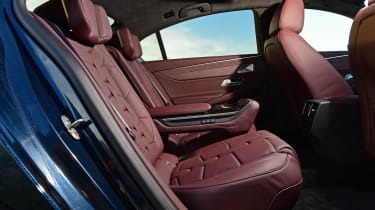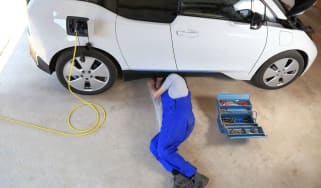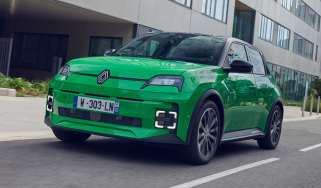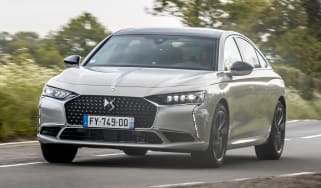DS 9 E-TENSE hybrid review
The plug-in hybrid DS 9 saloon is comfortable, luxurious, refined and loaded with kit – but looks too expensive on finance compared to German rivals
Pros
- Comfortable
- Luxury features
- Excellent refinement
Cons
- Laggy infotainment
- Mediocre electric range
- High monthly finance payments
| Model | Electric range | Fuel economy | CO2 emissions |
|---|---|---|---|
| E-TENSE 250 | 40 miles | 214mpg | 26g/km |
| E-TENSE 360 4x4 | 29 miles | 131mpg | 41g/km |
The market for big four-door saloon cars in the UK has contracted sharply in recent years – unless you’re one of the big premium players like BMW, Audi or Mercedes. It’s something the French have wrestled with for a couple of decades now; Renault, Peugeot and even Citroen saloons have long failed to win the hearts of international executives. But DS reckons it can now mix it with the premium players with this swoopy DS 9.
Having initially been launched with a choice of petrol or plug-in hybrid power, the range went hybrid-only as part of an update in early 2022. As well as dropping the petrol version, DS also introduced a new E-TENSE 250 plug-in model to replace the E-TENSE 225. A range-topping E-TENSE 360 4x4 was also brought in.
The focus on plug-in hybrid power is unsurprising given that the primary market for this cars and others like it is company-car drivers. Most of them are likely to gravitate towards the front-wheel-drive E-TENSE 250, as its cheaper list price, longer electric range and lower CO2 emissions compared to the 360 all add up to a lower Benefit-in-Kind (BiK) bill.
Those numbers are competitive with rivals like the BMW 530e and Mercedes E 300 e plug-in hybrids, but if you're a private buyer using finance, the picture is less positive: the DS' poorer predicted residual values mean there's more depreciation to account for, so monthly payments are higher than for the German cars.
We’ll come on to what the DS 9 is like to drive in a moment, but inside is where the designers have made the greatest leaps towards the brand's more established rivals. Quality is excellent, with loads of high-end plastics, metals and leathers spread across the dashboard and doors. The infotainment system in the centre stack and BRM clock atop the dashboard are well integrated, even if the usual DS caveats apply; the touchscreen is laggy and the graphics feel dated. At least Apple CarPlay and Android Auto are standard.
There are two versions of the DS 9 to choose from: Performance Line+ and Rivoli+, both of which bring an impressive level of equipment. The entry-level car gets black Alcantara upholstery, 19-inch wheels, LED lights front and rear, plus two 12-inch screens inside. Rivoli+ adds ventilated and massaging leather seats, a 360-degree camera and semi-autonomous driving. DS also offers sumptuous 'watchstrap' leather seats as part of the pricey Opera option pack – shown in our pictures with deep red leather and Alcantara headlining.
As well as all that, DS promises a unique ownership experience. Buying or leasing a DS 9 gives you access to the company’s ‘Only You’ programme – effectively providing a direct dial to a single contact to help with servicing and roadside assistance, along with anything else a conventional dealer might usually cater for.
Push the DS 9 E-TENSE's starter button and the car springs into life all but silently, provided there’s enough charge in the batteries. In its electric mode (available at speeds of up to 84mph) it’s particularly quiet and refined; it’s a little less composed when the engine kicks in, but that’s less noticeable at speed. Speaking of which, the DS 9’s ride is especially accomplished on the motorway. It wafts along, but with a level of poise that prevents the sense of feeling disconnected from the road. It’s caught out on occasion by larger potholes, but in general, it’s a very comfortable car to drive.
Performance is adequate rather than particularly noteworthy: 0-62mph takes just over eight seconds and the electric motor helps fill any gaps you might otherwise notice in power delivery. Wring out the DS 9’s 1.6-litre petrol engine though, and it does start to feel a little bit strained. The steering is light but accurate, and body control is fine. The DS 9 isn’t the last word in precision – the 5 Series still takes the prize there – but it isn’t sloppy. This isn’t a car you’ll relish driving with much gusto, then, but for the sorts of jobs the DS 9 will be tasked with that's unlikely to matter.
The E-TENSE 360 4x4 model (above) introduced as part of the early 2022 update uses the same powertrain found in the Peugeot 508 Peugeot Sport Engineered. That means an extra electric motor on the rear axle for four-wheel-drive grip, a total power output of 355bhp and a significantly faster 0-62mph time of 5.6 seconds. But a shorter electric range and higher CO2 emissions than the E-TENSE 250 mean it sits a few percentage points higher when it comes to Benefit-in-Kind (BiK) tax, limiting its appeal to company-car buyers.
DS hasn't just boosted engine power in the 360 and left it at that: the car also gets upgraded brakes with larger discs, plus a wider track (the distance between the wheels when viewed head-on) and lower ride height to help it deal with the extra output and offer sportier handling, too. But there's still an emphasis on comfort: the 360 gets DS' 'Active Scan' suspension – which looks out for bumps or potholes ahead and primes the car to deal with them – as standard.
So how does this all work in practice? It's a mixed bag. The Active Scan is a nice idea, but proves inconsistent in the real world, sometimes missing imperfections that lead to sharp bumps making their way into the cabin. Like all DS 9s, though, the 360 is extremely quiet inside, thanks to acoustic glass. On the handling front, the 360 is more agile, precise and grippy than you might expect of a comfort-focused executive saloon, but still not as satisfying as the BMW 5 Series class benchmark.
As we mentioned, comfort is a DS 9 strong point, however the amount of rear-seat space is disappointing compared to what you might expect looking at the car from outside. It's not cramped per se, but there's no more legroom than in any other car in this class. Headroom isn’t as generous as you might like either, but anyone under six foot should be fine. Along with the glass roof, the aforementioned Opera option pack adds a huge central armrest with a pair of cupholders and a storage tray.
The 510-litre boot is a good shape and size. It’s not as big as the load area you’ll find in a petrol or diesel Mercedes E-Class, but it trumps the hybrid version of that car, which comes with a huge step in the boot floor. The DS 9 benefits from a small area under the floor, too – perfect for storing the charge cable.
Every version of the DS 9 E-TENSE comes with a 7kW on-board charger and a lead for wallbox charging, which allows you to top up the batteries in around an hour and 45 minutes. You’ll want to do this as often as possible, as in our experience, even when the car is driven relatively gently, the official maximum electric range remains largely out of reach.
Overall, the DS 9 E-TENSE is a difficult car to comprehensively recommend. It's unquestionably a luxurious and refined vehicle, but its main German rivals are better to drive, just as practical and – crucially – more affordable on monthly finance. It's hard to ignore, too, that you can get the same plug-in hybrid setup in the Peugeot 508 Hybrid – also for a lower monthly payment.

